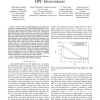Free Online Productivity Tools
i2Speak
i2Symbol
i2OCR
iTex2Img
iWeb2Print
iWeb2Shot
i2Type
iPdf2Split
iPdf2Merge
i2Bopomofo
i2Arabic
i2Style
i2Image
i2PDF
iLatex2Rtf
Sci2ools
134
click to vote
ISCA
2012
IEEE
2012
IEEE
A case for random shortcut topologies for HPC interconnects
—As the scales of parallel applications and platforms increase the negative impact of communication latencies on performance becomes large. Fortunately, modern High Performance Computing (HPC) systems can exploit low-latency topologies of high-radix switches. In this context, we propose the use of random shortcut topologies, which are generated by augmenting classical topologies with random links. Using graph analysis we find that these topologies, when compared to non-random topologies of the same degree, lead to drastically reduced diameter and average shortest path length. The best results are obtained when adding random links to a ring topology, meaning that good random shortcut topologies can easily be generated for arbitrary numbers of switches. Using flit-level discrete event simulation we find that random shortcut topologies achieve throughput comparable to and latency lower than that of existing non-random topologies such as hypercubes and tori. Finally, we discuss and qu...
| Added | 28 Sep 2012 |
| Updated | 28 Sep 2012 |
| Type | Journal |
| Year | 2012 |
| Where | ISCA |
| Authors | Michihiro Koibuchi, Hiroki Matsutani, Hideharu Amano, D. Frank Hsu, Henri Casanova |
Comments (0)

